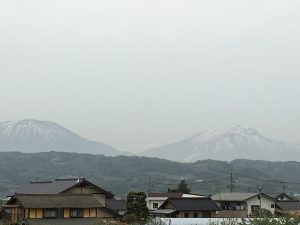Our train to Takayama, the next stop on what seems to be this whistle-stop tour of Japan, didn’t leave until 11:45, so we decided to get up early and visit Obuse, a small village just to the NE of Nagano. It is an adorable town, with several walking paths through chestnut groves and past a sake brewery. The view of the Japanese Alps in the distance was a bit obscured but it was clear that this would be a lovely valley village. Seeing some preschoolers enroute to a field trip with their minders was a wonderful diversion. What I noted from the train rides today (both this route and the next) was how every bit of land seems to be put to use. Little backyard gardens are being tended right next to the tracks, and there are rice fields in every spare quarter.
The sole purpose of our early train was to go to the Hokusai Museum. And clearly the town is celebrating this fact — the handles on the train were decorated with Hokusai images! It was in this small town that the artist Katsushika Hokusai, the master Japanese print maker, chose to settle during the last years of his life. And he bequeathed many works to the town. Many of his original works are one display, as well as ink drawings and wall scrolls as well as two festival floats with his designs. His fame came late in life, and his best known work is the series called “Thirty-six Views of Mt. Fuji”, which actually contained 46 different illustrations. The most famous is probably “The Great Wave off Kanagawa”, and while it was wonderful to see those originals, I also enjoyed some of his works of everyday life in Japan, where the people always seems engaged and joyous. It was a detour well worth taking.
Then it was off to Takayama, which took two trains to get to. We had to travel north to Toyama, at the Sea of Japan, and then south from there — no easy route across the Alps. Surrounded by mountains that rise to almost 10,000ft, this place seems frozen in time. Thanks to the old districts dating from the Edo period, with wooden houses, sake breweries, antique shops, temples and shaded shrines, this town has both character and atmosphere, something I felt was missing from Nagano. The area is poor in agricultural resources but rich in wood for building, so Takayama was renowned for its skilled carpenters, considered the best in Japan. The merchant quarter is well preserved with little houses neatly aligned one after the other, running the length of the narrow streets. Only one or two stories high, they have gently sloping roofs ending in wide canopies, and facades with dark wooden doors and latticework. The effect is one of harmony and coherence. We enjoyed strolling these streets and stopping into little shops along the way, listening to the river dance over the rocks below.
It was a long day, so an early dinner at a local spot — many restaurants are closed on Tuesdays, so it was good to find a place for some Hida beef and noodles that was open. The little place we found even had some lovely art on the wall above our table — would be great to know what the words were!

















